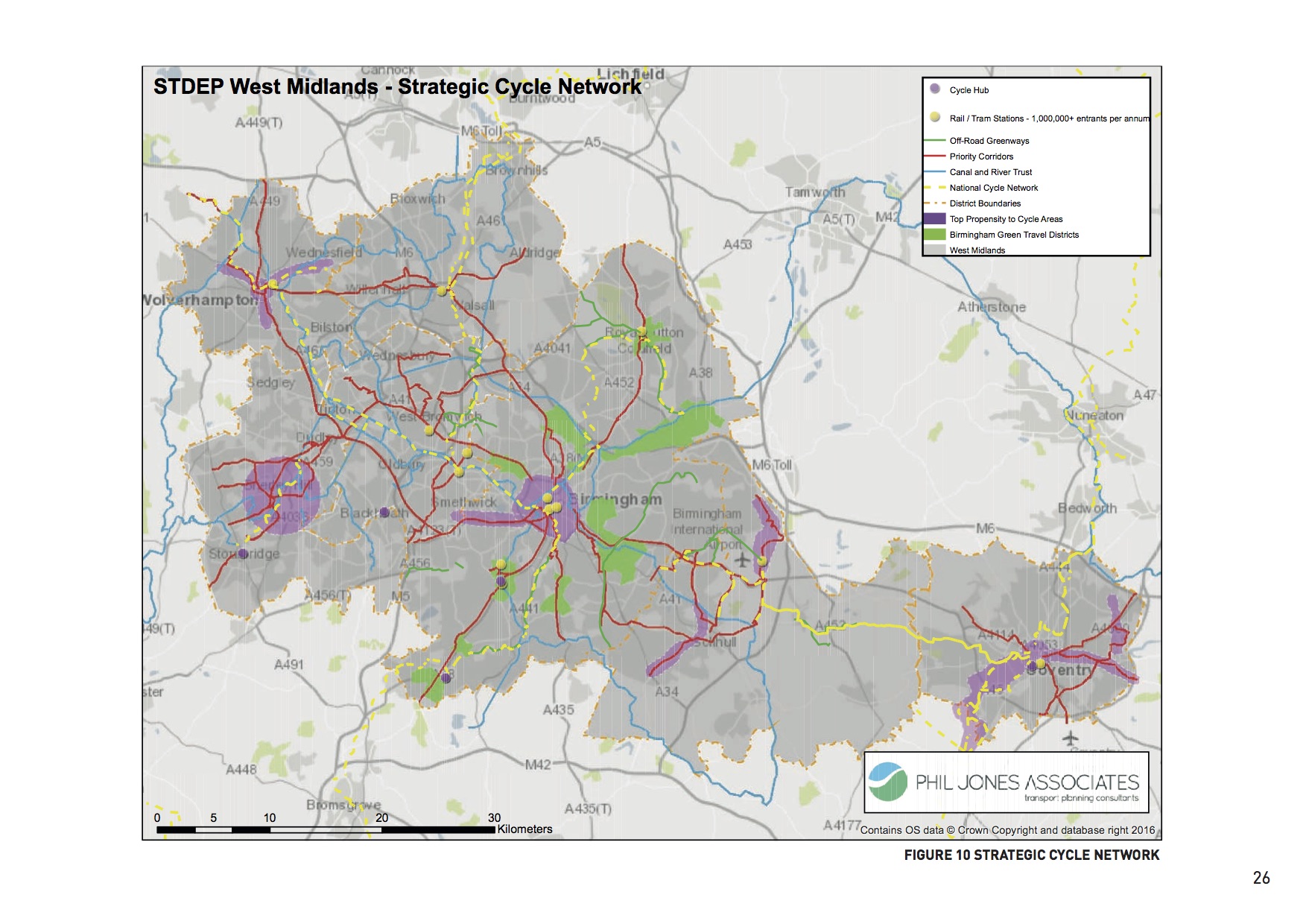
The West Midlands Combined Authority (WMCA) is consulting on it's 10 year delivery plan for transport, the 2026 Delivery Plan for Transport, which you can find on the Transport for West Midlands website (TfWM). The consultation closes on Friday 9th June, and so it may not be receiving quite as much attention as expected due to another political consultation being held the day before on the 8th June.
The challenge outlined by the delivery plan is that the WMCA is hoping that economic growth in Birmingham will lead to an extra 500,000 jobs by 2030, with 1.2 million extra daily journeys. Clearly some improvements will need to be made to the transport network to carry those extra journeys, and the delivery plan is supposed to show what plans the WMCA has for making those improvements. The document presents two over-arching principles: (1) connecting all parts of the West Midlands to the 2 HS2 stations in the area; (2) guiding investment into 'priority corridors', where the WMCA hopes to achieve joined up planning of new jobs and homes. The Delivery Plan is made up of lists of all the transport projects that the constituent local authorities have on their shelves, some of which have already had funds allocated to them and others which are little more than a twinkle in their planner's eye. In total, the list amounts to £8 billion, of which we have estimated £133 million is for active travel schemes. That makes up 1.66% of the total investment, or £2.38 per person per year in the West Midlands. As Andy Street committed to a spending level of £10 per person per year on cycling schemes during his mayoral campaign, we've drafted up a letter to him concerning this shortfall in ambition. You can read more in the link, and send an email to Andy Street yourself, to put pressure on him to improve this situation.
What is our response to the 2026 Delivery Plan for Transport?
Below this section, I've written out some more detailed comments and notes on the consultation document, but you might not want to read those, so here are some key responses that you can take away. In the consultation, you will be asked if you agree on the different sections of the document. In general they are quite good, and you can grade them appropriately, but here are some sections that you might want to suggest some improvements could be made to:
(1) Joined-up delivery of infrastructure for all modes of transport:
The TfWM Cycling Charter clearly states that to increase cycling rates, we need to rethink how we design and build our transport infrastructure: "The needs of all road users, including cyclists, are considered from the outset in the designing of all new and upgraded road improvements across the network – avoiding expensive retrofitting." (Point 2 in the Cycling Network section). This is supported by section 2.25 of the DfT's LCWIP technical guidance, which states that "Good cycling and walking schemes are often delivered as part of comprehensive street redesigns that bring benefits to a wide range of users." This language is lacking from the 2026 Delivery Plan for Transport, and should be inserted. If the WMCA is to achieve its targets for increasing cycling usage, they must get main road infrastructure delivered with every new highways scheme.
Section 16, on Co-ordinated Delivery in Corridors, is perhaps the most appropriate place to make this comment. You could ask that in Section 16, the WMCA add the following words: "When bringing forward any proposals for delivery the promoting authorities will seek to maximise any opportunities for delivering appropriate cycling infrastructure at the same time, to avoid expensive retrofitting later on."
Another appropriate location is Section 14, on Mobility for Health and for a Clean Environment. You could ask that in this section, the following words are added: "In order to avoid expensive retrofitting later on, all schemes in this delivery plan will be checked against the regional strategic cycle network and the local cycle network for opportunities to deliver appropriate cycling infrastructure at the same time."
Finally, in section 5, on the Strategic Road and Key Route Networks, co-ordinated planning of maintenance is discussed. You could ask that that section, in 5.7, the text is amended to read: "for example in reducing the number times the highway is dug up for statutory utilities work or maintenance, and delivering cycling infrastructure during the maintenance cycle."
(2) Recognise the role of cycles in mobility and social inclusion:
Roughly 30% of households in the West Midlands do not have a car, and even in households with a car there are competing demands on the use of it. Public transport can not cover every trip, and some excluded people may not qualify for access to services such as Ring and Ride. Children and younger people need access to good cycle networks as well as cheap public transport networks. In addition, cycle networks must be designed to be used by devices such as mobility scooters, which includes features such as good surfaces and no 'dismount' signs. The language in section 13 needs to be amended to specifically say this, because otherwise it will be forgotten by those officers working from this document.
(3) Shifting focus from 'Park and Ride' to 'Cycle and Ride':
Sections 4, on Trains, and 5, on the Key Road Network, discuss new Park and Ride schemes. We don't know how many new parking spaces they intend, but if just 5% of the new trips in 2030 used Park and Ride, that would need another 30,000 car parking spaces, compared with 7,500 at current facilities (See below for more details). Cycle parking is much more space efficient, and could be implemented at many more stations.
In Section 5, they need to discuss building cycle infrastructure that will deliver cycle users to the Cycle and Ride facilities. In Section 4, they need to discuss providing appropriate cycle parking at stations and public transport hubs to encourage more people to cycle, as well as working to improve the local road environment. In Section 14, they need to discuss integrating cycle use with public transport, and Section 15 also needs to discuss cycling to 'Park and Ride' locations as part of cutting air pollution.
(4) Rapid Transit and cycles:
On Section 9, in the discussion of Sprint rapid transit buses, there is a brief mention about considering the needs of other road users in when designing and implementing Sprint routes. All improvements to public transport are welcome, but there are specific issues when cycles and rapid transit vehicles, trams or Sprint buses, share the same space, and a lot of the rapid transit routes are along the same roads as the Strategic Cycle Network. Where rapid transit has priority over other motor vehicles, the temptation will be there for cycle users to use the rapid transit lanes, but where this includes tram tracks or being overtaken by 21 metre long bendy buses, this is not safe. Providing separate safe and attractive space for cycling alongside rapid transit provision should be seen as a complement to the public transport mix.
In Section 9, there needs to be an acknowledgement that much of the rapid transit and strategic cycle network lie side-by-side, and that the specific needs of cycles and the hazards presented by rapid transit to cycles will be prioritised and the strategic cycle network developed at the same time as the rapid transit network.
More general comments:
The draft document states that the 10 year plan is intended to be a rolling plan, updated every year (see section 3.4) with the local authorities providing details of new funds they have allocated to the projects and adding new projects to the list. If this is updated every year and made public, then it will provide a useful tool for checking on what plans are being made for cycling, although one caveat is that where cycle infrastructure is included in wider plans, it isn't necessarily flagged up as cycling investment. For example the £133 million we identified included some town centre improvement works that didn't explicitly say that they would help facilitate cycling. Also, if cycling is included in a wider scheme, it can be difficult to know what cost is appropriate to nominally allocate to that. This is an issue that will need to be watched for as the yearly updates are released.
Table 1 in the document (pages 2 and 3) outline priorities for Movement for Growth, and cycling appears in both the Metropolitan Tier and the Local Tier. At the Metropolitan level, the phrase 'high quality segregated cycle route provision' is used for the cycle network, but at the local level, that language is missing. Although local networks may make a lot of use of quieter routes, with an unravelling of the motor and cycle networks, there will still be a need for cycle provision on main roads, and that ought to be high quality segregation. We hope that the omission in Table 1 is for brevity's sake.
The document discusses the strategic road and key route network (in section 5), introducing the West Midlands Key Route Network (KRN), which is 592 km of roads carrying strategic local movement and providing access to the UK's strategic road network. The WM KRN is 7% of the road network that the WMCA is responsible for, yet carries 50% of car, public transport and freight movements. Section 5 includes a list of priorities (see 5.7) for managing this network, which includes reference to a 'live performance dashboard' that includes air pollution monitoring, and policies on maintenance such as reducing the number of times highways are dug up for maintenance. The last one is important for cycling provision, as highway maintenance is a key opportunity to install cycle infrastructure for reduced cost - and we are pushing for cycle infrastructure improvements to be factored into this process (see point 1 above).
Another interesting section is on Park & Ride schemes. Table 2 (on pg 10 of the consultation document) has a list of potential sites, while several other sections refer to new and existing Park and Ride schemes. None of these sections say anything about encouraging people to cycle to the train and bus stations, however, which means that WMCA are expecting more people to drive and park their cars. Remember that there is expected to be an extra 1.2 million journeys each day by 2030 - imagine if just 5% of those extra journeys involved driving a car to a Park & Ride. That would be 30,000 cars (2.5% of 1.2 million, assuming a 2-way daily journey). Currently, WMCA have 59 Park and Ride facilities, with 7,500 car parking spaces. The current parking spaces would have to quintuple to accommodate just 5% of the extra daily journeys, let alone encourage more people to replace existing journeys with Park and Ride. Cycle parking is, however, much more space efficient: Groningen train station had roughly 9,800 cycle parking spaces in 2010 (perhaps more now), while Cambridge has recently opened a new cycle parking facility at its central station, with 2,850 spaces. Park and Ride is not a solution for mass transport because individual cars take up too much space, but if WMCA focused on encouraging people to cycle short, manageable distances to take public transport, the potential is enormous without covering swathes of the West Midlands with parked cars.
'Rapid Transit' also has some interesting details (Section 9), with a proposed network map of planned Metro Lines (Figure 4, page 15) showing increased connectivity through the Black Country. 'Sprint' rapid transit bus lines are also being considered, with section 9.14 having Hagley Road and the A45 from Birmingham to Solihull via the airport as the first 2 schemes to be completed in the next 5 years. There are significant highways engineering and traffic management issues with installing a rapid transit bus network - there has to be priority for these services, free from congestion, or they are no longer 'rapid transit' buses, but just awkward bendy-buses. Of course that separate space is very tempting for people riding bicycles, as some South American cities have found. Section 9.16 does say that the design of the Sprint rapid transit routes would require "wider highway efficiency measures" to be considered, so that other road user groups also benefit, and much of the projected rapid transit network is on the same roads as the Strategic Cycle Network. On parts of Hagley Road it is difficult to see where the space for segregated space for the buses could be found, let alone also for cycles. In these circumstances, use may need to be made of parallel cycle routes, but they must be direct and attractive or many cycle users will stick with Hagley Road. In contrast, on the A45 it should be possible to ensure that cycle users can enjoy high quality segregated tracks, delivered at the same time as the work for the Sprint network, which would result in reduced disruption and no need for retro-fitting cycle infrastructure.
London has had contactless payment for several years now, and WMCA has recently brought out the SWIFT card. The consultation document discusses the idea of 'Mobility as a service' (MaaS) (see section 12.7 onwards) to incorporate not just public transport, but also taxis, car sharing and rental schemes, and bike-sharing, into a single mobility service which users can get access to through 1 account. We know that WMCA are looking at introducing bike-hire schemes in a couple of locations in the West Midlands in the next year or two - being able to access those bike-hire schemes with a SWIFT card would be a huge boost to their viability.
This theme of talking about 'mobility' rather than individual forms of transport carries through into section 13 (Mobility & Social Inclusion) and section 14 (Mobility for Health & Clean Environment) of the document. There is discussion of a Mobility for Inclusion Strategy, to look at how to help excluded groups to access the transport network (see section 13) however it focuses mainly on access to public transport, which can not provide solutions for trips that do not lie along public transport routes. About 30% of West Midlands households do not have a car and no-one below the age of 17 can drive a car anyway - it is important that these groups have the ability to make journeys that many people with cars take for granted. Walking is too slow, and some people have disabilities that prevent them from walking very far - the solution is to provide a transport network that facilitates trips by cycle and devices such as mobility scooters. In the Netherlands the same transport network is used by both groups as their design needs are quite similar. It is important that WMCA takes this on-board and understands cycling serves a very wide group of people.
Section 14 discusses the impact of transport on ill-health, and the ways in which greater physical activity can be encouraged through transport choices. It is at this point that the document discusses the role of cycling in the West Midland's transport mix, both for cutting air pollution and encouraging more active travel, with section 15 covering the Clean Air Zones that the national government has been pushing recently. It is grating that cycling has been relegated to a supporting role in a topic such as the environment, and shows that cycling is still a long way from being taken seriously as a mode of transport in its own right by influential parts of TfWM. That gripe aside, let's look at what is said. Section 14.5 introduces the strategic cycle network, which section 14.6 tells us will be "progressively integrated with the local cycle network" over a period of 10+ years. We can see the first outline of that strategic cycle network in Figure 10 (which I've reproduced at the end of this document). It is good to have a clear skeleton of a network in this document, but without the transport projects to deliver that network being in the 10 year plan, it isn't going to get very far.
The co-ordination of delivery is covered in section 16, with the two main principles - connecting to HS2 and joined up land use and transport planning. With the money and resources dedicated to the other transport modes, and the subsequently plethora of transport schemes, that works ok. But for cycling, which has had so little attention and has traditionally been an after thought, this does not work. That is why we have inserted a demand that section 16 specifically mentions cycling as an issue to be considered in all the transport schemes - in order to deliver the network of main road routes in the Strategic Cycle Network, there needs to be a specific requirement to consider the needs of cycling in every project. We can't wait for cycling projects alone to deliver the network - if we do that, it will take the next 200 years to achieve. Cycling must be embedded in every project.
Strategic cycle network



